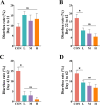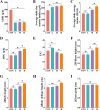Exploring the growing phase forest musk deer (Moschus berezovskii) dietary energy requirements based on growth performance and gut microbiota analysis
- PMID: 39873507
- PMCID: PMC11878060
- DOI: 10.1128/spectrum.02352-24
Exploring the growing phase forest musk deer (Moschus berezovskii) dietary energy requirements based on growth performance and gut microbiota analysis
Abstract
The forest musk deer (FMD) farming industry is currently experiencing rapid growth, yet the dietary energy requirements for FMD remain unclear. Therefore, we explored the optimal dietary digestible energy (DE) for growing phase FMD by providing three diets with different DE levels and analyzing changes in gut microbiota. A total of 20 six-month-old FMD were used in a 62-day trial. Animals were fed either traditional feed (CON, 10.38 MJ/kg DE) or pelleted diets with low (L, 8.87 MJ/kg), medium (M, 10.38 MJ/kg), or high (H, 11.86 MJ/kg) DE levels. The results showed that feeding pelleted diets significantly reduced the incidence of diarrhea (P < 0.05). The average daily gain in the H group was significantly higher than in the M group, and the M group was higher than both the L and CON groups (P < 0.05). Additionally, the H group showed the highest nutrient digestibility and the greatest increase in body measurements (P < 0.05). Analysis of fecal microbiota revealed that α-diversity and the relative abundance of Firmicutes increased with higher dietary energy levels, while the relative abundance of Bacteroidetes decreased. Beneficial bacteria such as Akkermansia and Lachnospira were significantly enriched in the H group. In conclusion, our findings suggest that pelleted diets are suitable for growing phase FMD, with an optimal dietary DE level of 11.86 MJ/kg.
Importance: This study underscores the significance of identifying the optimal dietary digestible energy (DE) for growing forest musk deer (FMD). Pelleted diets with a DE level of 11.86 MJ/kg enhanced growth performance, nutrient digestibility, and gut health, while reducing diarrhea and enriching beneficial gut bacteria, offering valuable insights for improving FMD farming practices.
Keywords: 16S rRNA; Moschus berezovskii; digestible energy; fecal microbiota; growth performance.
Conflict of interest statement
The authors declare no conflict of interest.
Figures






Similar articles
-
Exploring the growing forest musk deer (Moschus berezovskii) dietary protein requirement based on gut microbiome.Front Microbiol. 2023 Mar 9;14:1124163. doi: 10.3389/fmicb.2023.1124163. eCollection 2023. Front Microbiol. 2023. PMID: 36970665 Free PMC article.
-
Active dry yeast enhances immunity through modulation of gut microbiota and serum metabolic processes in captive forest musk deer (Moschus berezovskii).BMC Vet Res. 2025 Apr 12;21(1):262. doi: 10.1186/s12917-025-04705-z. BMC Vet Res. 2025. PMID: 40221712 Free PMC article.
-
Marked Seasonal Variation in Structure and Function of Gut Microbiota in Forest and Alpine Musk Deer.Front Microbiol. 2021 Sep 6;12:699797. doi: 10.3389/fmicb.2021.699797. eCollection 2021. Front Microbiol. 2021. PMID: 34552569 Free PMC article.
-
Dietary supplementation with Epimedium contributes to the improvement of hormone levels, gut microbiota, and serum metabolite composition in the Chinese forest musk deer (Moschus berezovskii).Front Vet Sci. 2025 Jan 22;11:1497115. doi: 10.3389/fvets.2024.1497115. eCollection 2024. Front Vet Sci. 2025. PMID: 39911481 Free PMC article.
-
Digestibility of calcium in calcium-containing ingredients and requirements for digestible calcium by growing pigs.J Anim Sci. 2023 Jan 3;101:skad328. doi: 10.1093/jas/skad328. J Anim Sci. 2023. PMID: 37758207 Free PMC article. Review.
References
-
- Xiuxiang M, Caiquan Z, Jinchu H, Cao L, Zhibin M, Jinchao F, Yijun Z, Yinjiu Z. 2006. Musk deer farming in China. Anim Sci 82:1–6. doi:10.1079/ASC200516 - DOI
-
- Wang Y, Sun M, Chang F, Wang J, Wang Y, Tang J, Zhang K, Gao L, Xue X, Wan Y. 2022. The essential differences in microbial and chemical components of musk of different qualities secreted by captive male forest musk deer (Moschus berezovskii). Microb Biotechnol 15:1783–1794. doi:10.1111/1751-7915.14002 - DOI - PMC - PubMed
-
- .Yang CC. 2022. Activity rhythm of Moschus berezovskii in Hunan Hupingshan national nature reserve by infrared camera technology Dissertation/master’s thesis, Central South University of Forestry and Technology, Changsha
-
- Zhang J. 2020. Investigation on captive breeding of forest musk deer (Moschus berezovskii) and transcriptome sequencing analysis of musk gland Dissertation/master’s thesis, Northwest A&F University, Yangling
MeSH terms
LinkOut - more resources
Full Text Sources

